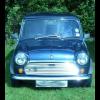Is the jet a waxstat type... This type of jet does adjust the mixture depending on temperature.
I've replaced mine with a fixed jet...
Here's how I did mine (copied from a post I did on another forum)
I've been reading around and apparently the waxstat jet fitted to the later HS4 carbs may be good for emmisions and economy but isn't the best for power.
Basically how it works is a heat sensitive unit expands and weakens the mixture.
I'd also read that it can cause problems setting up carbs so with that in mind I've converted to a fixed jet, I can't take credit for the method
This is the site I found that explained it http://www.nireland....ph/waxstats.htm
But here's a few pictures
Complete unit

Cap removed, be carefull its spring loaded. Easy enough to do, 3 tabs prise back

remove metal button, this normally goes between the jet and the waxstat unit

replace waxstat unit with 2 one pence coins, keep the metal button in its original postion

After removing my jet assy, I did find that my waxstat unit looked damaged so this could have been causing the problems that led me to investigate
right unit is a good one, left is my original
Slight amendment, had confirmation from other people that they also have a waxstat with the dent in the bottom, so looks like some of them are made like that


















